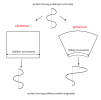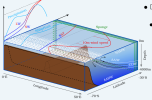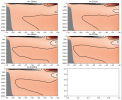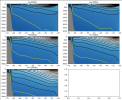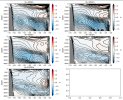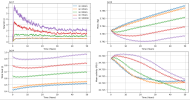Hi everyone,
I am still working on setting up a MOM6/SIS2 coupled sea ice/ocean configuration of a ACC-like reentrant channel model, as shown in the attached model_schematic.png.
Some explanations of my problem, my main question arrives after:
The latest, enduring problem I'm confronted with is that I seem unable to produce a coherent residual meridional overturning circulation, with the features that we expect it to have for this kind of model: two counter-rotating cells, with sinking of "AABW" + upwelling of "CDW" making the lower one, and upwelling of "CDW" + sinking of "AAIW" making the upper one.
I'm imposing a classic exponential temperature profile (decay length scale H) in the sponge, and a salinity profile that takes into account the fresh water "tongue" associated with AAIW in the real ocean (see the attached temperature.png and salinity.png for 10 years averages isocontours over the 40-50 first years of the simulation).
As one can see in the attached residual_MOC.png, whatever the temperature profile (changing the decay length scale H) I'm imposing in the sponge, a "sponge cell" seems to establish with hardly no connection with the adjacent ocean. The model seems to produce enough dense water through brine rejection.
Also, looking at global_diags.png, whatever the initial total heat content of the ocean (which depends on the initial T field, itself dependent on the extrapolated sponge profile), the ocean seems to be taking up heat from the imposed surface forcing. I would expect it to equilibrate at some point, which it does not even after ~200years of integration. I would expect that an initially warmer ocean (e.g. H=1000m) would tend to loose heat more rapidly, which it does not.
Main question: cartesian VS spherical coordinates and surface forcing
My model is set up in lon-lat coordinates, contrary to some similar models I can see in the literature (e.g. Abernathey et al. JPO 2011, Doddridge et al. GRL 2019, Styles et al. JGR 2023), which are set up in cartesian coordinates.
This means that for the same surface forcing per unit area meridional profile, the zonally integrated forcings are drastically different in the two cases, spherical coordinates leading to increased buoyancy forcing magnitude to the north (where the geographical extent is higher, in km), and vice versa in the south. A schematic of the situation is attached in cartesian_spherical_forcing.png.
I'm wondering if there's any consensus about this issue? I would say that the two ways of specifying the models lead to drastically different watermass transformation rates from surface forcing, the cartesian one overly emphasizing the southern forcing, generally associated with dense water formation in that context.
And so, I wonder if the sponge, whose role is to "close the loop" in the watermass transformation with the surface forcing, should accommodate for these different setups, and maybe (that's a big maybe) that's why I can't find the right sponge profile for my northern boundary, as I'm following cartesian-oriented ideas.
Sorry for the long question, I guess it's just a thought I'd like to share with the community, in case someone has already addressed it.
All the best,
Nelson
I am still working on setting up a MOM6/SIS2 coupled sea ice/ocean configuration of a ACC-like reentrant channel model, as shown in the attached model_schematic.png.
Some explanations of my problem, my main question arrives after:
The latest, enduring problem I'm confronted with is that I seem unable to produce a coherent residual meridional overturning circulation, with the features that we expect it to have for this kind of model: two counter-rotating cells, with sinking of "AABW" + upwelling of "CDW" making the lower one, and upwelling of "CDW" + sinking of "AAIW" making the upper one.
I'm imposing a classic exponential temperature profile (decay length scale H) in the sponge, and a salinity profile that takes into account the fresh water "tongue" associated with AAIW in the real ocean (see the attached temperature.png and salinity.png for 10 years averages isocontours over the 40-50 first years of the simulation).
As one can see in the attached residual_MOC.png, whatever the temperature profile (changing the decay length scale H) I'm imposing in the sponge, a "sponge cell" seems to establish with hardly no connection with the adjacent ocean. The model seems to produce enough dense water through brine rejection.
Also, looking at global_diags.png, whatever the initial total heat content of the ocean (which depends on the initial T field, itself dependent on the extrapolated sponge profile), the ocean seems to be taking up heat from the imposed surface forcing. I would expect it to equilibrate at some point, which it does not even after ~200years of integration. I would expect that an initially warmer ocean (e.g. H=1000m) would tend to loose heat more rapidly, which it does not.
Main question: cartesian VS spherical coordinates and surface forcing
My model is set up in lon-lat coordinates, contrary to some similar models I can see in the literature (e.g. Abernathey et al. JPO 2011, Doddridge et al. GRL 2019, Styles et al. JGR 2023), which are set up in cartesian coordinates.
This means that for the same surface forcing per unit area meridional profile, the zonally integrated forcings are drastically different in the two cases, spherical coordinates leading to increased buoyancy forcing magnitude to the north (where the geographical extent is higher, in km), and vice versa in the south. A schematic of the situation is attached in cartesian_spherical_forcing.png.
I'm wondering if there's any consensus about this issue? I would say that the two ways of specifying the models lead to drastically different watermass transformation rates from surface forcing, the cartesian one overly emphasizing the southern forcing, generally associated with dense water formation in that context.
And so, I wonder if the sponge, whose role is to "close the loop" in the watermass transformation with the surface forcing, should accommodate for these different setups, and maybe (that's a big maybe) that's why I can't find the right sponge profile for my northern boundary, as I'm following cartesian-oriented ideas.
Sorry for the long question, I guess it's just a thought I'd like to share with the community, in case someone has already addressed it.
All the best,
Nelson

